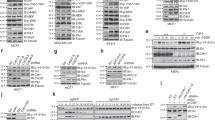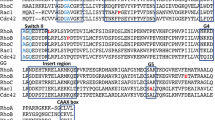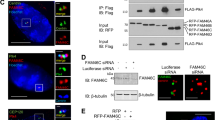Abstract
Autoinhibition of the Rho guanine nucleotide exchange factor ASEF is relieved by interaction with the APC tumor suppressor. Here we show that binding of the armadillo repeats of APC to a 'core APC-binding' (CAB) motif within ASEF, or truncation of the SH3 domain of ASEF, relieves autoinhibition, allowing the specific activation of CDC42. Structural determination of autoinhibited ASEF reveals that the SH3 domain forms an extensive interface with the catalytic DH and PH domains to obstruct binding and activation of CDC42, and the CAB motif is positioned adjacent to the SH3 domain to facilitate activation by APC. In colorectal cancer cell lines, full-length, but not truncated, APC activates CDC42 in an ASEF-dependent manner to suppress anchorage-independent growth. We therefore propose a model in which ASEF acts as a tumor suppressor when activated by APC and inactivation of ASEF by mutation or APC truncation promotes tumorigenesis.
This is a preview of subscription content, access via your institution
Access options
Subscribe to this journal
Receive 12 print issues and online access
$189.00 per year
only $15.75 per issue
Buy this article
- Purchase on Springer Link
- Instant access to full article PDF
Prices may be subject to local taxes which are calculated during checkout








Similar content being viewed by others
References
Fodde, R., Smits, R. & Clevers, H. APC, signal transduction and genetic instability in colorectal cancer. Nat. Rev. Cancer 1, 55–67 (2001).
Polakis, P. The adenomatous polyposis coli (APC) tumor suppressor. Biochim. Biophys. Acta 1332, F127–F147 (1997).
Segditsas, S. & Tomlinson, I. Colorectal cancer and genetic alterations in the Wnt pathway. Oncogene 25, 7531–7537 (2006).
Hanson, C.A. & Miller, J.R. Non-traditional roles for the Adenomatous Polyposis Coli (APC) tumor suppressor protein. Gene 361, 1–12 (2005).
Rossman, K.L., Der, C.J. & Sondek, J. GEF means go: turning on RHO GTPases with guanine nucleotide-exchange factors. Nat. Rev. Mol. Cell Biol. 6, 167–180 (2005).
Reid, T., Bathoorn, A., Ahmadian, M.R. & Collard, J.G. Identification and characterization of hPEM-2, a guanine nucleotide exchange factor specific for CDC42. J. Biol. Chem. 274, 33587–33593 (1999).
Hamann, M.J., Lubking, C.M., Luchini, D.N. & Billadeau, D.D. Asef2 functions as a CDC42 exchange factor and is stimulated by the release of an autoinhibitory module from a concealed C-terminal activation element. Mol. Cell. Biol. 27, 1380–1393 (2007).
Kawasaki, Y. et al. Asef, a link between the tumor suppressor APC and G-protein signaling. Science 289, 1194–1197 (2000).
Kawasaki, Y., Sato, R. & Akiyama, T. Mutated APC and Asef are involved in the migration of colorectal tumour cells. Nat. Cell Biol. 5, 211–215 (2003).
Worthylake, D.K., Rossman, K.L. & Sondek, J. Crystal structure of RAC1 in complex with the guanine nucleotide exchange region of Tiam1. Nature 408, 682–688 (2000).
Gao, Y., Xing, J., Streuli, M., Leto, T.L. & Zheng, Y. Trp(56) of rac1 specifies interaction with a subset of guanine nucleotide exchange factors. J. Biol. Chem. 276, 47530–47541 (2001).
Karnoub, A.E. et al. Molecular basis for RAC1 recognition by guanine nucleotide exchange factors. Nat. Struct. Biol. 8, 1037–1041 (2001).
Cheng, L. et al. RhoGEF specificity mutants implicate RhoA as a target for Dbs transforming activity. Mol. Cell. Biol. 22, 6895–6905 (2002).
Snyder, J.T. et al. Structural basis for the selective activation of Rho GTPases by Dbl exchange factors. Nat. Struct. Biol. 9, 468–475 (2002).
Nobes, C.D. & Hall, A. Rho, rac, and cdc42 GTPases regulate the assembly of multimolecular focal complexes associated with actin stress fibers, lamellipodia, and filopodia. Cell 81, 53–62 (1995).
Nobes, C.D. & Hall, A. Rho GTPases control polarity, protrusion, and adhesion during cell movement. J. Cell Biol. 144, 1235–1244 (1999).
Thiesen, S., Kubart, S., Ropers, H.H. & Nothwang, H.G. Isolation of two novel human RhoGEFs, ARHGEF3 and ARHGEF4, in 3p13–21 and 2q22. Biochem. Biophys. Res. Commun. 273, 364–369 (2000).
Gotthardt, K. & Ahmadian, M.R. Asef is a CDC42-specific guanine nucleotide exchange factor. Biol. Chem. 388, 67–71 (2007).
Nalbant, P., Hodgson, L., Kraynov, V., Toutchkine, A. & Hahn, K.M. Activation of endogenous CDC42 visualized in living cells. Science 305, 1615–1619 (2004).
Kins, S., Betz, H. & Kirsch, J. Collybistin, a newly identified brain-specific GEF, induces submembrane clustering of gephyrin. Nat. Neurosci. 3, 22–29 (2000).
Nathke, I. Cytoskeleton out of the cupboard: colon cancer and cytoskeletal changes induced by loss of APC. Nat. Rev. Cancer 6, 967–974 (2006).
Munemitsu, S. et al. The APC gene product associates with microtubules in vivo and promotes their assembly in vitro. Cancer Res. 54, 3676–3681 (1994).
Rosin-Arbesfeld, R., Ihrke, G. & Bienz, M. Actin-dependent membrane association of the APC tumour suppressor in polarized mammalian epithelial cells. EMBO J. 20, 5929–5939 (2001).
Kurokawa, K., Itoh, R.E., Yoshizaki, H., Nakamura, Y.O. & Matsuda, M. Coactivation of RAC1 and CDC42 at lamellipodia and membrane ruffles induced by epidermal growth factor. Mol. Biol. Cell 15, 1003–1010 (2004).
Watanabe, T. et al. Interaction with IQGAP1 links APC to RAC1, CDC42, and actin filaments during cell polarization and migration. Dev. Cell 7, 871–883 (2004).
Smith, K.J. et al. Wild-type but not mutant APC associates with the microtubule cytoskeleton. Cancer Res. 54, 3672–3675 (1994).
Li, S.S. Specificity and versatility of SH3 and other proline-recognition domains: structural basis and implications for cellular signal transduction. Biochem. J. 390, 641–653 (2005).
Xiang, S. et al. The crystal structure of CDC42 in complex with collybistin II, a gephyrin-interacting guanine nucleotide exchange factor. J. Mol. Biol. 359, 35–46 (2006).
Murayama, K. et al. Crystal structure of the rac activator, Asef, reveals its autoinhibitory mechanism. J. Biol. Chem. 282, 4238–4242 (2007).
Soisson, S.M., Nimnual, A.S., Uy, M., Bar-Sagi, D. & Kuriyan, J. Crystal structure of the Dbl and pleckstrin homology domains from the human Son of sevenless protein. Cell 95, 259–268 (1998).
Morin, P.J. et al. Activation of beta-catenin-Tcf signaling in colon cancer by mutations in beta-catenin or APC. Science 275, 1787–1790 (1997).
El-Bahrawy, M., Poulsom, R., Rowan, A.J., Tomlinson, I.T. & Alison, M.R. Characterization of the E-cadherin/catenin complex in colorectal carcinoma cell lines. Int. J. Exp. Pathol. 85, 65–74 (2004).
Feig, L.A. Tools of the trade: use of dominant-inhibitory mutants of Ras-family GTPases. Nat. Cell Biol. 1, E25–E27 (1999).
Sjoblom, T. et al. The consensus coding sequences of human breast and colorectal cancers. Science 314, 268–274 (2006).
Etienne-Manneville, S. & Hall, A. Rho GTPases in cell biology. Nature 420, 629–635 (2002).
Knudson, A.G. Two genetic hits (more or less) to cancer. Nat. Rev. Cancer 1, 157–162 (2001).
Doublie, S. Preparation of selenomethionyl proteins for phase determination. Methods Enzymol. 276, 523–530 (1997).
Snyder, J.T., Singer, A.U., Wing, M.R., Harden, T.K. & Sondek, J. The pleckstrin homology domain of phospholipase C-beta2 as an effector site for Rac. J. Biol. Chem. 278, 21099–21104 (2003).
Otwinowski, Z. & Minor, W. Processing of x-ray diffraction data collected in oscillation mode. Methods Enzymol. 276, 307–326 (1997).
Sheldrick, G.M. SHELXS86—Program for Crystal Structural Solution (University of Gottingen, Germany, 1986).
Collaborative Computational Project, Number 4. The CCP4 suite: programs for protein crystallography. Acta Crystallogr. D Biol. Crystallogr. 50, 760–763 (1994).
Cowtan, K.D. DM: an automated procedure for phase improvement by density modification. Joint CCP4 ESF-EACBM Newsl. Protein Crystallogr. 31, 34–38 (1994).
McCoy, A.J., Grosse-Kunstleve, R.W., Storoni, L.C. & Read, R.J. Likelihood-enhanced fast translation functions. Acta Crystallogr. D Biol. Crystallogr. 61, 458–464 (2005).
Emsley, P. & Cowtan, K. Coot: model-building tools for molecular graphics. Acta Crystallogr. D Biol. Crystallogr. 60, 2126–2132 (2004).
Murshudov, G.N., Vagin, A.A. & Dodson, E.J. Refinement of macromolecular structures by the maximum-likelihood method. Acta Crystallogr. D Biol. Crystallogr. 53, 240–255 (1997).
Acknowledgements
We thank D. Thiel and L. Bauer for technical assistance, Keith Burridge, (University of North Carolina) for the gift of GST-PAK RBD, the M. Hooker imaging facility at the University of North Carolina, Chapel Hill, and the staff at the SER-CAT beamlines for help with data collection. Use of the Advanced Photon Source was supported by the US Department of Energy, Office of Science, Office of Basic Energy Sciences, under contract no. W-31-109-Eng-38. J.S. is supported by grants GM65533 and GM62299 from the US National Institutes of Health. C.J.D. is supported by grant CA063071 from the US National Institutes of Health. K.L.R. is supported by postdoctoral fellowship grant PF-05-129-01(GMC) from the American Cancer Society.
Author information
Authors and Affiliations
Contributions
N.M. and K.L.R. conceived, analyzed and performed experiments and wrote the manuscript. L.B. assisted with the structural determination of ASEF. M.E.Y. contributed ideas and assisted with construct design and protein purification. J.S. and C.J.D. contributed ideas and evaluated and discussed data.
Corresponding authors
Ethics declarations
Competing interests
The authors declare no competing financial interests.
Supplementary information
Supplementary Text and Figures
Supplementary Figures 1–5, Supplementary Data, Supplementary Discussion, Supplementary Methods (PDF 10088 kb)
Rights and permissions
About this article
Cite this article
Mitin, N., Betts, L., Yohe, M. et al. Release of autoinhibition of ASEF by APC leads to CDC42 activation and tumor suppression. Nat Struct Mol Biol 14, 814–823 (2007). https://doi.org/10.1038/nsmb1290
Received:
Accepted:
Published:
Issue Date:
DOI: https://doi.org/10.1038/nsmb1290
This article is cited by
-
Rational design of a sensitivity-enhanced tracer for discovering efficient APC–Asef inhibitors
Nature Communications (2022)
-
A RAC-GEF network critical for early intestinal tumourigenesis
Nature Communications (2021)
-
Multiplexed GTPase and GEF biosensor imaging enables network connectivity analysis
Nature Chemical Biology (2020)
-
Systems analysis of RhoGEF and RhoGAP regulatory proteins reveals spatially organized RAC1 signalling from integrin adhesions
Nature Cell Biology (2020)
-
Hypermethylation of DMTN promotes the metastasis of colorectal cancer cells by regulating the actin cytoskeleton through Rac1 signaling activation
Journal of Experimental & Clinical Cancer Research (2018)



